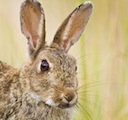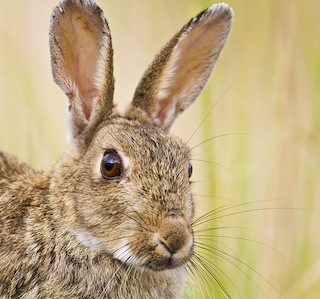 We’re very familiar with rabbits in Britain, but did you know they are in serious decline in their native range in south-west Europe?
We’re very familiar with rabbits in Britain, but did you know they are in serious decline in their native range in south-west Europe?
Photo: © Natural England/Allan Drewitt
Scientific name: Oryctolagus cuniculus
Other common names: Coney, European Rabbit, Common Rabbit, Bunny
Cornish name: Conyn
Conservation status: IUCN Red List, Near Threatened (within native range)
What to look for:
- Appearance and colouring: Grey-brown fur, pale belly, brown tail with familiar white underside as it speeds away, long upward-pointing ears, four incisor teeth, hopping gait when moving. Colour variations do occur, including black (melanistic) and white (albino) forms.
- Size: Length 45 to 70 cm.
- Where: Several habitats, including woodland edges, grassland, sand dunes – wherever the ground is suitable for digging burrows.
- Similar to: Brown Hare, which is much less common on The Lizard.
 The Rabbit needs no introduction. This very familiar mammal, famed for its warrens, social lifestyle and starring roles in literature and Disney movies, was originally a native of south-western Europe and north-western Africa. It is now found in many other parts of the world, including Britain, where it arrived with the Romans.
The Rabbit needs no introduction. This very familiar mammal, famed for its warrens, social lifestyle and starring roles in literature and Disney movies, was originally a native of south-western Europe and north-western Africa. It is now found in many other parts of the world, including Britain, where it arrived with the Romans.
Despite its abundance in the UK and other areas where it has been introduced, the Rabbit is endangered within its native range. This is due to changes in habitat and hunting, and also to the diseases myxomatosis and rabbit calcivirus.
Did you know…?
…the European Rabbit is the only rabbit species to have been domesticated. All our pet rabbit types ultimately derive from its wild form.
…the Rabbit’s incisor teeth continue growing throughout its life.
More information and references:
Cornwall Mammal Group, 2013. The Mammals of Cornwall and the Isles of Scilly (edited by David Groves). Environmental Records Centre for Cornwall and the Isles of Scilly (ERCCIS), Cornwall.
Published: December 2014
Author: Amanda Scott
Photo: © Natural England/Allan Drewitt
